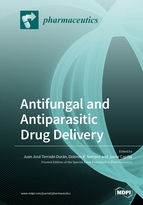Antifungal and Antiparasitic Drug Delivery
A special issue of Pharmaceutics (ISSN 1999-4923).
Deadline for manuscript submissions: closed (11 October 2019) | Viewed by 42636
Special Issue Editors
Interests: conventional pharmaceutical dosage forms (tablets, capsules, semisolid and liquid formulations); new controlled release systems (pellets, nanoparticles, microcapsules, microspheres and liposomes) including production and quality control
Special Issues, Collections and Topics in MDPI journals
Interests: nanomedicines; microparticles; sustained-release formulations; liposomes; nanoparticles; drug targeting; pharmacokinetics
Special Issues, Collections and Topics in MDPI journals
Interests: the study and development of antifungal therapies against opportunistic fungal infections as well as virulence factors of fungi causing human infections
Special Issues, Collections and Topics in MDPI journals
Special Issue Information
Dear Colleagues,
Fungal and parasitic diseases affect more than a billion people across the globe, one-sixth of the world´s population, mostly located in developing countries. The lack of effective and safer treatments combined with a deficient diagnosis lead to serious chronic illness or even death. There is a mismatch between the rate of drug resistance and the development of new medicines. Formulation of antifungal and antiparasitic drugs adapted to different administration routes is challenging bearing in mind their poor water solubility, which limits their bioavailability and efficacy. Hence, there is an unmet clinical need to develop vaccines and novel formulations and drug delivery strategies that can improve the bioavailability and therapeutic effect by enhancing their dissolution, increasing their chemical potency, stabilising the drug and targeting high concentration of drug to the infection sites. In this issue, an update on novel drug delivery strategies of antifungal and antiparasitic drugs to treat both topical and systemic infections will be discussed.
Prof. Dr. Juan J. Torrado
Dr. Dolores R. Serrano
Dr. Javier Capilla
Guest Editors
Manuscript Submission Information
Manuscripts should be submitted online at www.mdpi.com by registering and logging in to this website. Once you are registered, click here to go to the submission form. Manuscripts can be submitted until the deadline. All submissions that pass pre-check are peer-reviewed. Accepted papers will be published continuously in the journal (as soon as accepted) and will be listed together on the special issue website. Research articles, review articles as well as short communications are invited. For planned papers, a title and short abstract (about 100 words) can be sent to the Editorial Office for announcement on this website.
Submitted manuscripts should not have been published previously, nor be under consideration for publication elsewhere (except conference proceedings papers). All manuscripts are thoroughly refereed through a single-blind peer-review process. A guide for authors and other relevant information for submission of manuscripts is available on the Instructions for Authors page. Pharmaceutics is an international peer-reviewed open access monthly journal published by MDPI.
Please visit the Instructions for Authors page before submitting a manuscript. The Article Processing Charge (APC) for publication in this open access journal is 2900 CHF (Swiss Francs). Submitted papers should be well formatted and use good English. Authors may use MDPI's English editing service prior to publication or during author revisions.
Keywords
- liposomes
- transferosomes
- nanoparticles
- emulsions
- candidiasis
- aspergillosis
- azoles
- amphotericin B
- combined therapy
- quality by design
- leishmaniasis
- malaria, trypanosomiais
Related Special Issue
- Antifungal and Antiparasitic Drug Delivery Volume II in Pharmaceutics (5 articles)







